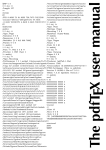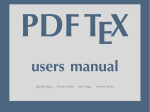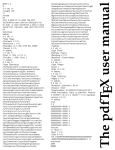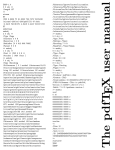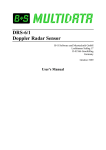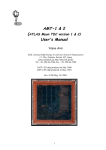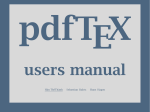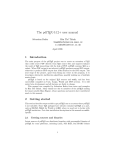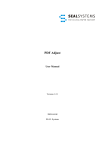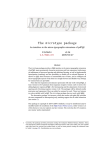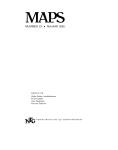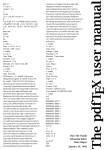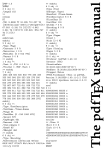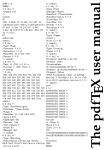Download integer
Transcript
pdfTEX
users manual
Hàn Thê Thành
Sebastian Rahtz
Hans Hagen
Contents
1
2
3
4
5
Introduction
About PDF
Getting started
Macro packages supporting PDFTEX
Setting up fonts
6
7
8
Formal syntax specification
New primitives
Graphics and color
Abbreviations
1 Introduction
The main purpose of the pdfTEX project was to create an extension of TEX that can create pdf directly from
TEX source files and improve/enhance the result of TEX typesetting with the help of pdf. When pdf output
is not selected, pdfTEX produces normal dvi output, otherwise it produces pdf output that looks identical
to the dvi output. An important aspect of this project is to investigate alternative justification algorithms,
optionally making use of multiple master fonts.
pdfTEX is based on the original TEX sources and Web2c, and has been successfully compiled on Unix, Win32
and MSDos systems. It is still under beta development and all features are liable to change. Despite its β-state, pdfTEX produces excellent pdf code.
As pdfTEX evolves, this manual will evolve and more background information will be added. Be patient with
the authors.
This manual is typeset in ConTEXt. One can generate an A4 version from the source code by saying:
pdftex-t
texexec
An letter size variant is also supported:
texexec
content
--mode=letter
pdftex-t
The pdfTEX user manual
exit
Given that the A4 version is typeset, one can generate a booklet by saying:
texexec --pdfarrange --paper=a5a4 --print=up --addempty=1,2 pdftex-t
This also demonstrates that pdfTEX can be used for page imposition purposes (given that pdfTEX and the
fonts are set up all right).
We thank all readers who send us corrections and suggestions. We also wish to express the hope that pdfTEX
will be of as much use to you as it is to us. Since pdfTEX is still being improved and extended, we suggest
you keep track of updates.
2 About PDF
The cover of this manual shows a simple pdf file. Unless compression and/or encryption is applied, such a
file is rather verbose and readable. The first line specifies the version used; currently pdfTEX produces level
1.2 output. Viewers are supposed to silently skip over all elements they cannot handle.
A pdf file consist of objects. These objects can be recognized by their number and keywords:
8 0 obj << /Type /Catalog /Pages 6 0 R >> endobj
Here 8 0 obj ... endobj is the object capsule. The first number is the object number. Later we will see
that pdfTEX gives access to this number. One can for instance create an object by using \pdfobj after which
\pdflastobj returns the number. So
\pdfobj{/Type /Catalog /Pages 6 0 R}
content
The pdfTEX user manual
exit
inserts an object into the file, while \pdflastobj returns the number pdfTEX assigned to this object. The
sequence 6 0 R is an object reference, a pointer to another object. The second number (here a zero) is
currently not used in pdfTEX; it is the version number of the object. It is for instance used by pdf editors,
when they replace objects by new ones.
In general this rather direct way of pushing objects in the files is rather useless and only makes sense when
implementing for instance fill--in field support or annotation content reuse. We will come to that later.
Unless such direct objects are part of something larger, they will end up as isolated entities, not doing any
harm but not doing any good either.
When a viewer opens a pdf file, it first goes to the end of the file. There it finds the keyword startxref, the
signal where to look for the so called ‘object cross reference table’. This table provides fast access to the
objects that make up the file. The actual starting point of the file is defined after the trailer. The /Root
entry points to the catalog. In this catalog the viewer can find the page list. In our example we have only
one page. The trailer also holds an /Info entry, which tells a bit more about the document. Just follow the
thread:
/Root −→ object 8 −→ /Pages −→ object 6 −→ /Kids −→ object 2 −→ page content
This one page example uses an Adobe Times Roman font. This is one of the 14 fonts that is always present
in the viewer application, and is called a base font. However, when we use for instance Computer Modern
Roman, we have to make sure that this font is available, and the best way to do this is to embed it in the file.
content
The pdfTEX user manual
exit
The page content is a stream of drawing operations. Such a stream can be compressed, where the level
of compression can be set with \pdfcompresslevel. Let’s take a closer look at this stream. First there
is a transformation matrix, six numbers followed by cm. As in PostScript, the operator comes after the
operands. Between BT and ET comes the text. A font switch can be recognized as /F... The actual text goes
between () so that it creates a PostScript string. When one analyzes a file produced by a less sophisticated
typesetting engine, whole sequences of words can be recognized. In TEX however, the text comes out rather
fragmented, mainly because a lot of kerning takes place. Because viewers can search in these streams, one
can imagine that the average TEX produced files becomes more difficult as soon as the typesetting engine
does a better job; TEX cannot do less.
As soon as we add annotations, a fancy word for hyperlinks and alike, some more entries are present in the
catalog. We invite users to take a look at the pdf code of this file to get an impression of that.
In this simple file, we don’t specify in what way the file should be opened, for instance full screen or clipped.
A closer look at the page object (/Type /Page) shows that a mediabox is part of the page description.
A mediabox acts like the bounding box in a PostScript file. pdfTEX users have access to this object by
\pdfpageattr.
3 Getting started
Although in most cases macro packages will shield users from these internals, pdfTEX provides access to
many of the entries described here, either automatically by translating the TEX data structures into pdf
ones, or manually by pushing entries to the catalog, page, info or self created objects. Those who, after this
introduction, feel uncomfortable in how to proceed, are advised to read on but skip section 7. Before we
come to that section, we will describe how to get started with pdfTEX.
Just let your eyes follow the object thread and see how a font is described. The only thing missing in this
example is the (partially) embedded glyph description file, which for the base fonts is not needed.
This section describes the steps needed to get pdfTEX running on a system where pdfTEX is not yet installed.
Some TEX distributions have pdfTEX as a component, like teTEX, fpTEX, MikTeX and CMacTEX, so when you
use one of them, you don’t need to bother with the pdfTEX installation. Note that the installation description
in this manual is Web2c--specific.
For some years there has been a ‘moderate’ successor to TEX available, called e-TEX. Because the main stream
macro packages start supporting this welcome extension, pdfTEX also is available as pdfe-TEX. Although in
this document we will speak of pdfTEX, we advise users to use pdfe-TEX when available. That way they get
the best of all worlds and are ready for the future.
The latest sources of pdfTEX are distributed together with precompiled binaries of pdfTEX for some platcontent
The pdfTEX user manual
exit
3.1 Getting sources and binaries
ftp://ftp.cstug.cz/pub/tex/local/cstug/thanh/pdftex/latest
forms, including Linux 1 , SGI IRIX, Sun SPARC Solaris and MSDos (djgpp). 2 The primary location where one
can fetch the source code (by version) is:
Thomas Esser’s teTEX distribution comes with precompiled versions for many Unix systems. More information can be found at: http://www.tug.org/teTeX. For Win32 systems (Windows 95, Windows NT) there are
two packages that contain pdfTEX, both in ctan:systems/win32: fpTEX, maintained by Fabrice Popineau,
[email protected], and MikTeX by Christian Schenk, [email protected].
3.2 Compiling
1The
Linux binary is compiled for the new libc-6 (gnu glibc-2.0), which will not run for users of older Linux installations still based
on libc-5.
2The djgpp version is built by djgpp 2.0 cross--compiler on Linux.
content
The pdfTEX user manual
exit
cd $HOME/pdftex
gunzip < web-7.3.tar.gz | tar xvf gunzip < web2c-7.3.tar.gz | tar xvf gunzip < pdftex.tar.gz | tar xvf mv pdftexdir web2c-7.3/web2c
cd web2c-7.3
./configure
cd web2c
make pdftex
If there is no precompiled binary of pdfTEX for your system, you need to build pdfTEX from sources. The
compilation is expected to be easy on Unix--like systems and can be described best by example. Assuming
that all needed files are downloaded to $HOME/pdftex, on a Unix system the following steps are needed to
compile pdfTEX:
If you happen to have a previously configured source tree and just install a new version of pdfTEX, you can
avoid running configure from the top--level directory. It’s quicker to run config.status, which will just
regenerate the Makefile’s based on config.cache:
cd web2c-7.3/web2c
sh config.status
make pdftex
For Unix users the savest way to generate binaries is to get the latest teTEX and follow the instructions that
come with it.
Apart from the binary of pdfTEX the compilation also produces several other files which are needed for
running pdfTEX:
pdftex.pool The pool file, needed for creating formats, located in web2c-7.3/web2c
texmf.cnf Web2c run--time configuration file, located in web2c-7.3/kpathsea
ttf2afm An external program to generate afm files from TrueType fonts, located in web2c-7.3/web2c
/pdftexdir
Precompiled binaries are included in the zip archive pdftex.zip.
3.3 Getting PDFTEX--specific platform--independent files
Apart from the above--mentioned files, there is another zip archive (pdftexlib.zip) in the pdfTEX distribution which contains platform--independent files required for running pdfTEX:
configuration file: pdftex.cfg
encoding vectors: *.enc
map files: *.map
macros: *.tex
content
•
•
•
•
The pdfTEX user manual
exit
Unpacking this archive —don’t forget the -d option when using pkunzip— will create a texmf tree containing
pdfTEX--specific files.
3.4 Placing files
The next step is to place the binaries somewhere in PATH. If you want to use LATEX, you also need to make a
copy (or symbolic link) of pdftex and name it pdflatex. The files texmf.cnf and pdftex.pool and the
directory texmf, created by unpacking the file pdftexlib.zip, should be moved to the ‘appropriate’ place
(see below).
3.5 Setting search paths
Virtual fonts are fonts made up of others and vf files play an important role in this
process. Because pdfTEX produces the final output code, it must consult those files.
T1FONTS
Outline (vector) fonts are to be prefered over bitmap pk fonts. In most cases Type 1 fonts
are used and this variable tells pdfTEX where to find them.
TTFONTS
Like Type 1 fonts, TrueType fonts are also outlines.
MISCFONTS
pdfTEX is able to read so called pdf glyph container files. These contain fonts descriptions in pdf format. (A separate manual will be made available soon.)
content
The pdfTEX user manual
exit
VFFONTS
Web2c--based programs, including pdfTEX, use the Web2c run--time configuration file called texmf.cnf. This
file can be found via the user--set environment variable TEXMFCNF or via the compile--time default value if
the former is not set. It is strongly recommended to use the first option. Next you need to edit texmf.cnf
so pdfTEX can find all necessary files. Usually one has to edit TEXMFS and maybe some of the next variables.
When running pdfTEX, some extra search paths are used beyond those normally requested by TEX itself:
format
texmf.cnf
virtual fonts
type1 fonts
truetype fonts
pgc fonts
pdftex.cfg
images
map files
encoding files
kpse
kpse
kpse
kpse
kpse
kpse
kpse
kpse
VFFONTS
T1FONTS
TTFONTS
MISCFONTS
TEXINPUTS
TEXINPUTS
TEXPSHEADERS
TEXPSHEADERS
vf format
type1 format
truetype format
miscfonts format
tex format
tex format
tex ps header format
tex ps header format
used for
Table 1 The Web2c variables.
Unfortunately bitmap fonts are displayed poorly by pdf viewers, so when possible one
should use outline fonts. When no outline is available, pdfTEX tries to locate a suitable
pk font (or invoke a process that generates them).
TEXINPUTS
This variable specifies where pdfTEX finds its configuration file and input files. Being a
postprocessor too, image files are considered input files and searched for along this path.
TEXPSHEADERS
This is the path where pdfTEX looks for the font mapping files (*.map) and encoding files
(*.enc). Both types provide pdfTEX the information needed for embedding font encoding
vectors and font resources.
One has to keep in mind that, opposed to dvi output, there is no postprocessing stage. This has several rather
fundamental consequences, like one--pass graphic and font inclusion. When TEX builds a page, the macro
content
The pdfTEX user manual
exit
3.6 The PDFTEX configuration file
PKFONTS
Most dvi postprocessors enable the user to specify the paper size, which often defaults to ‘A4’ or ‘letter’.
In most cases it does not harm that much to mix the two, because one will seldom put too small paper in
the printer. And, if one does, one will certainly not do that a second time. In pdf the paper size is part of
the definition. This means that everything that is off page, is clipped off, it simply disappears. Even worse,
just like in a PostScript file, the reference point is in the lower corner, which is opposite to dvi’s reference
point.
And so, we’ve found one of the main reasons why pdfTEX explicitly needs to know the paper dimensions.
These dimensions can either be passed using the so called configuration file, or by using the primitives
provided for this purpose. In this respect, the pdfTEX configuration file can be compared to configuration
files that come with dvi postprocessors and/or command line options. Both contain information on the
paper used, the fonts to be included and optimizations to be applied.
package used quite certain has a concept of page dimensions, which is not the same as paper dimensions.
The reference point of the page is the top--left corner.
When pdfTEX is run in ini--mode, which is normally the case when we generate a format file, the configuration
file is not read at all, and all configuration parameters are set to 0 by default for both integer and dimension
parameters.
When pdfTEX is launched in non--ini mode, it reads the Web2c configuration file as well as the pdfTEX configuration file called pdftex.cfg, searched for in the TEXINPUTS path. As Web2c systems commonly specify
a ‘private’ tree for pdfTEX where configuration and map files are located, this allows individual users or
projects to maintain customized versions of the configuration file. The configuration file must exist when
pdfTEX is run (except when generating a format).
content
The pdfTEX user manual
exit
The integer configuration parameters replace the corresponding internal ones just before pdfTEX starts
reading the input file. At this moment the format is already loaded, so any former settings during creating formats will be overwritten by the values from config file. So, unless the macro package used resets
When at the moment the first page is shipped out \pdfoutput has positive value, the configuation parameters that are dimension overwrite only the corresponding internal ones that are 0. The value of \pdfoutput
cannot be changed after the first page has been shipped out.
\pdfoutput, pdfTEX will produce pdf output! Macros (packages) that adapt themselves to either dvi (using
specials) or pdf (dedicated primitives) should be aware of this.
Most parameters in the configuration file have a corresponding internal register. When not set during the
TEX run, pdfTEX uses the values as specified in the configuration file.
parameters
type
\pdfoutput
\pdfadjustspacing
\pdfcompresslevel
\pdfdecimaldigits
\pdfmovechars
\pdfimageresolution
\pdfpkresolution
\pdfhorigin
\pdfvorigin
\pdfpageheight
\pdfpagewidth
\pdflinkmargin
\pdfthreadmargin
output format
integer
adjust spacing level integer
compress level
integer
decimal digits
integer
move chars
integer
image resolution
integer
pk resolution
integer
horigin
dimension
vorigin
dimension
page height
dimension
page width
dimension
link margin
dimension
thread margin
dimension
internal name
Apart from the above described parameters, the configuration file can have another entry named map. This
content
The pdfTEX user manual
exit
Figure 1 The configuration parameters.
entry specifies the font mapping files, which is similar to those used by many dvi to PostScript drivers.
More than one map file can be specified, using multiple map lines. If the name of the map file is prefixed
with a +, its values are appended to the existing set, otherwise they replace it. If no map files are given, the
default value psfonts.map is used.
A typical pdftex.cfg file looks like this, setting up output for A4 paper size and the standard TEX offset of
1 inch, and loading two map files for fonts:
1
1
3
300
600
1
210 true mm
297 true mm
1 true in
1 true in
pdftex.map
+misc.map
%
%
%
%
%
%
%
%
%
%
%
%
the implicit output will be PDF
use the fastest level of compression
max. 3 digits after the decimal point
when not specified, embed images at 300 DPI
use PK fonts at 600 DPI
move chars in 0..31 to higher area
A4 paper width
A4 paper height
horizontal origin offset
vertical origin offset
standard map file
map file for extra fonts
output_format
compress_level
decimal_digits
image_resolution
pk_resolution
move_chars
page_width
page_height
horigin
vorigin
map
map
The configuration file sets default values for these parameters, and apart from the map entry, they all can
be over--ridden in the TEX source file. Dimensions can be specified as true, which makes them immune for
magnification (when set).
compress level This integer parameter specifies the level of text and in--line graphics compression. pdfTEX
uses zip compression as provided by zlib. A value of 0 means no compression, 1 means fastest, 9 means
content
The pdfTEX user manual
exit
output format This integer parameter specifies whether the output format should be dvi or pdf. A positive
value means pdf output, otherwise we get dvi output.
decimal digits This integer specifies the preciseness of real numbers in pdf page descriptions. It gives the
maximal number of decimal digits after the decimal point of real numbers. Valid values are in range 0..5. A
higher value means more precise output, but also results in a much larger file size and more time to display
or print. In most cases the optimal value is 2. This parameter does not influence the precision of numbers
used in raw pdf code, like that used in \pdfliteral and annotation action specifications.
best, 2..8 means something in between. Just set this value to 9, unless there is a good reason to do otherwise
— 0 is great for testing macros that use \pdfliteral.
image resolution When pdfTEX is not able to determine the natural dimensions of an image, it assumes a
resolution of type 72 dots per inch. Use this variable to change this default value.
move chars Although pdf output is claimed to be portable, especially when all font information is included
in the file, problems with printing and viewing have a persistent nature. Moving the characters in range 0-31
sometimes helps a lot. When set to 1, characters are only moved when a font has less than 128 glyphs, when
set to 2 higher slots are used too.
pk resolution One can use this entry to specify the resolution for bitmap fonts. Nowadays most printers
are capable to print at least 600 dots per inch, so this is a reasonable default.
page width & page height These two dimension parameters specify the output medium dimensions (the
paper, screen or whatever the page is put on). If they are not specified, the page width is calculated as
wbox being shipped out + 2 × (horigin + \hoffset). The page height is calculated in a similar way.
horigin & vorigin These dimension parameters can be used to set the offset of the TEX output box from
the top left corner of the ‘paper’.
content
The pdfTEX user manual
exit
map This entry specifies the font mapping file, which is similar to those used by many dvi to PostScript
drivers. More than one map file can be specified, using multiple map lines. If the name of the map file is
prefixed with a +, its values are appended to the existing set, otherwise they replace it. If no map files are
given, the default value psfonts.map is used.
3.7 Creating formats
Formats for pdfTEX are created in the same way as for TEX. For plain TEX and LATEX it looks like:
pdftex -ini -fmt=pdftex
plain
pdftex -ini -fmt=pdflatex latex.ltx
\dump
In ConTEXt the generation depends on the interface used. A format using the english user interface is
generated with
pdftex -ini -fmt=cont-en cont-en
When properly set up, one can also use the ConTEXt command line interface TEXexec to generate one or
more formats, like:
texexec --make en
for an english format, or
texexec --make --tex=pdfetex en de
for an english and german one, using pdfe-TEX. Indeed, if there is pdfTEX as well as pdfe-TEX, use it! Whatever
macro package used, the formats should be placed in the TEXFORMATS path. We strongly recommend to use
pdfe-TEX, if only because the main stream macro packages (will) use it.
3.8 Testing the installation
When everything is set up, you can test the installation. In the distribution there is a plain TEX test file
example.tex. Process this file by saying:
If the installation is ok, this run should produce a file called example.pdf. The file example.tex is also a
good place to look for how to use pdfTEX’s new primitives.
content
The pdfTEX user manual
exit
pdftex example
The most common problem with installations is that pdfTEX complains that something cannot be found. In
such cases make sure that TEXMFCNF is set correctly, so pdfTEX can find texmf.cnf. The next best place to
look/edit is the file texmf.cnf. When still in deep trouble, set KPATHSEA_DEBUG=255 before running pdfTEX
or run pdfTEX with option -k 255. This will cause pdfTEX to write a lot of debugging information that can
be useful to trace problems. More options can be found in the Web2c documentation.
3.9 Common problems
Variables in texmf.cnf can be overwritten by environment variables. Here are some of the most common
problems you can encounter when getting started:
• I can’t read pdftex.pool; bad path?
• You have to increase POOLSIZE.
TEXMFCNF is not set correctly and so pdfTEX cannot find texmf.cnf, or TEXPOOL in texmf.cnf doesn’t
contain a path to the pool file pdftex.pool or pdfetex.pool when you use pdfe-TEX.
pdfTEX cannot find texmf.cnf, or the value of pool_size specified in texmf.cnf is not large enough
and must be increased. If pool_size is not specified in texmf.cnf then you can add something like
pool_size = 500000
• I can’t find the format file ‘pdftex.fmt’!
I can’t find the format file ‘pdflatex.fmt’!
Format is not created (see above how to do that) or is not properly placed. Make sure that TEXFORMATS
in texmf.cnf contains the path to pdftex.fmt or pdflatex.fmt.
This appears if you forgot to regenerate the .fmt files after installing a new version of the pdfTEX binary
and pdftex.pool.
content
The pdfTEX user manual
exit
• Fatal format file error; I’m stymied.
This might appear if you forgot to install the proper pdftex.pool when installing a new version of the
pdfTEX binary.
• TEX.POOL doesn’t match; TANGLE me again!
TEX.POOL doesn’t match; TANGLE me again (or fix the path).
• pdfTEX cannot find the configuration file pdftex.cfg, one or more map files (*.map), encoding vectors
(*.enc), virtual fonts, Type 1 fonts, TrueType fonts or some image file.
Make sure that the required file exists and the corresponding variable in texmf.cnf contains a path to
the file. See above which variables pdfTEX needs apart from the ones TEX uses.
Normally the page content takes one object. This means that one seldom finds more than a few hundred
objects in a simple file. This document for instance uses about 300 objects. In demanding applications this
number can grow quite rapidly, especially when one uses a lot of widget annotations, shared annotations
or other shared things. In these situations in texmf.cnf one can enlarge pdfTEX’s internal object table by
adding a line in texmf.cfg, for instance:
obj_tab_size = 400000
4 Macro packages supporting PDFTEX
As a direct result, when one uses a high level macro package, the macros that take care of these features
have to be set up properly. Specials for instance make no sense at all. Actually being a comment understood
by dvi postprocessors —given that the macro package speaks the specific language of this postprocessor—
content
The pdfTEX user manual
exit
When producing dvi output, for which one can use pdfTEX as well as any other TEX, part of the job is
delegated to the dvi postprocessor, either by directly providing this program with commands, or by means
of \specials. Because pdfTEX directly produces the final format, it has to do everything itself, from handling
color, graphics, hyperlink support, font--inclusion, upto page imposition and page manipulation.
When one wants to get some insight to what extend pdfTEX specific support is needed, one can start a file
by saying:
a \special would end up as just a comment in the pdf file, which is of no use. Therefore, \special issues
a warning when pdfTEX is in pdf mode.
\pdfoutput=1 \let\special\message
or, if this leads to confusion,
\pdfoutput=1 \def\special#1{\write16{special: #1}}
And see what happens. As soon as one ‘special’ message turns up, one knows for sure that some kind of
pdfTEX specific support is needed, and often the message itself gives a indication of what is needed.
Currently all main stream macro packages offer pdfTEX support in one way or the other. When using such
a package, it makes sense to turn on this support in the appropriate way, otherwise one cannot be sure if
things are set up right. Remember that for instance the page and paper dimensions have to be taken care
of, and only the macro package knows the details.
• For LATEX users, Sebastian Rahtz’ hyperref package has substantial support for pdfTEX, and provides
access to most of its features. In the simplest case, the user merely needs to load hyperref with a pdftex
option, and all cross--references will be converted to pdf hypertext links. pdf output is automatically
selected, compression is turned on, and the page size is set up correctly. Bookmarks are created to
match the table of contents.
• The standard LATEX graphics and color packages have pdftex options, which allow use of normal color,
text rotation, and graphics inclusion commands.
content
The pdfTEX user manual
exit
• The ConTEXt macro package by Hans Hagen ([email protected]) has very full support for pdfTEX in its
generalized hypertext features. Support for pdfTEX is implemented as a special driver, and is invoked by
saying \setupoutput[pdftex] or feeding TEXexec with the --pdf option.
• A similar modification of webmac.tex, called pdfwebmac.tex, allows production of hypertext’d pdf versions of programs written in web. This is also part of the pdfTEX distribution.
• Hypertexted pdf from texinfo documents can be created with pdftexinfo.tex, which is a slight modification of the standard texinfo macros. This file is part of the pdfTEX distribution.
Some nice samples of pdfTEX output can be found on the tug web server, at http://www.tug.org
/applications/pdftex and http://www.ntg.nl/context.
5 Setting up fonts
pdfTEX can work with Type 1 and TrueType fonts, but a source must be available for all fonts used in the
document, except for the 14 base fonts supplied by Acrobat Reader (Times, Helvetica, Courier, Symbol and
Dingbats). It is possible to use METAFONT--generated fonts in pdfTEX— but it is strongly recommended not
to use METAFONT--fonts if an equivalent is available in Type 1 or TrueType format, if only because bitmap
Type 3 fonts render very poorly in Acrobat Reader. Given the free availability of Type 1 versions of all the
Computer Modern fonts, and the ability to use standard PostScript fonts, most TEX users should be able to
experiment with pdfTEX.
5.1 Map files
3dvips
map files can be used with pdfTEX without problems.
content
The pdfTEX user manual
exit
pdfTEX reads the map files, specified in the configuration file, see section 3.6, in which reencoding and partial
downloading for each font are specified. Every font needed must be listed, each on a separate line, except
pk fonts. The syntax of each line is similar to dvips map files 3 and can contain up to the following (some
are optional) fields: texname, basename, fontflags, fontfile, encodingfile and special. The only mandatory
is texname and must be the first field. The rest is optional, but if basename is given, it must be the second
field. Similarly if fontflags is given it must be the third field (if basename is present) or the second field (if
basename is left out). It is possible to mix the positions of fontfile, encodingfile and special, however the
first three fields must be given in fixed order.
texname sets the name of the tfm file. This name must be given for each font.
basename sets the base (PostScript) font name. If not given then it will be taken from the font file.
Specifying a name that doesn’t match the name in the font file will cause pdfTEX to write a warning, so it is
best not to have this field specified if the font resource is available, which is the most common case. This
option is primarily intended for use of base fonts and for compatibility with dvips map files.
fontflags specify some characteristics of the font. The next description of these flags are taken, with a
slight modification, from the pdf Reference Manual (the section on Font Descriptor Flags).
The value of the flags key in a font descriptor is a 32--bit integer that contains a collection of boolean
attributes. These attributes are true if the corresponding bit is set to 1. Table 2 specifies the meanings
of the bits, with bit 1 being the least significant. Reserved bits must be set to zero.
All characters in a fixed--width font have the same width, while characters in a proportional font have
different widths. Characters in a serif font have short strokes drawn at an angle on the top and
bottom of character stems, while sans serif fonts do not have such strokes. A symbolic font contains
symbols rather than letters and numbers. Characters in a script font resemble cursive handwriting.
An all--cap font, which is typically used for display purposes such as titles or headlines, contains no
lowercase letters. It differs from a small--cap font in that characters in the latter, while also capital
letters, have been sized and their proportions adjusted so that they have the same size and stroke
weight as lowercase characters in the same typeface family.
content
The pdfTEX user manual
exit
Bit 6 in the flags field indicates that the font’s character set conforms the Adobe Standard Roman
Character Set, or a subset of that, and that it uses the standard names for those characters.
semantics
Fixed--width font
Serif font
Symbolic font
Script font
Reserved
Uses the Adobe Standard Roman Character Set
Italic
Reserved
All--cap font
Small--cap font
Force bold at small text sizes
Reserved
1
2
3
4
5
6
7
8–16
17
18
19
20–32
bit position
Table 2 The meaning of flags in the font descriptor.
Finally, bit 19 is used to determine whether or not bold characters are drawn with extra pixels even
at very small text sizes. Typically, when characters are drawn at small sizes on very low resolution
devices such as display screens, features of bold characters may appear only one pixel wide. Because
this is the minimum feature width on a pixel--based device, ordinary non--bold characters also appear
with one--pixel wide features, and cannot be distinguished from bold characters. If bit 19 is set,
features of bold characters may be thickened at small text sizes.
content
The pdfTEX user manual
exit
If the font flags are not given, pdfTEX treats it as being 4, a symbolic font. If you do not know the correct
value, it would be best not to specify it, as specifying a bad value of font flags may cause troubles in viewers.
On the other hand this option is not absolutely useless because it provides backward compatibility with
older map files (see the fontfile description below).
Note that the standard 14 fonts are never downloaded, even when they are specified to be downloaded
in map files. When one suffers from invalid lookups, for instance when pdfTEX tries to open a .pfa file
instead of a .pfb one, one can add the suffix to the filename. In this respect, pdfTEX completely relies on
the kpathsea libraries.
feature requires Acrobat Reader to have access to installed fonts on the system. This has been tested on
Win95 and Unix (Solaris).
encoding specifies the name of the file containing the external encoding vector to be used for the font. The
file name may be preceded by a <, but the effect is the same. The format of the encoding vector is identical
to that used by dvips. If no encoding is specified, the font’s built--in default encoding is used. It may be
omitted if you are sure that the font resource has the correct built--in encoding. In general this option is
highly preferred and is required when subsetting a TrueType font.
special instructions can be used to manipulate fonts similar to the way dvips does. Currently only the
keyword SlantFont is interpreted, other instructions are just ignored.
If a used font is not present in the map files, first pdfTEX will look for a source with suffix .pgc, which is a
so--called pgc source (pdf Glyph Container) 4 . If no pgc source is available, pdfTEX will try to use pk fonts
in a normal way as dvi drivers do, on--the--fly creating pk fonts if needed.
Lines containing nothing apart from texname stand for scalable Type 3 fonts. For scalable fonts as Type 1,
TrueType and scalable Type 3 font, all the fonts loaded from a tfm at various sizes will be included only once
in the pdf output. Thus if a font, let’s say csr10, is described in one of the map files, then it will be treated
as scalable. As a result the font source for csr10 will be included only once for csr10, csr10 at 12pt etc.
content
The pdfTEX user manual
exit
is a text file containing a pdf Type 3 font, created by METAPOST using some utilities by Hans Hagen. In general pgc files can
contain whatever allowed in pdf page description, which may be used to support fonts that are not available in METAFONT. At the
moment pgc fonts are not very useful, as vector Type 3 fonts are not displayed very well in Acrobat Reader, but it may be more useful
when Type 3 font handling gets better.
4This
csr10
So pdfTEX tries to do its best to avoid multiple downloading of identical font sources. Thus vector pgc fonts
should be specified as scalable Type 3 in map files like:
It doesn’t hurt much if a scalable Type 3 font is not given in map files, except that the font source will be
downloaded multiple times for various sizes, which causes a much larger pdf output. On the other hand if
a font is in the map files is defined as scalable Type 3 font and its pgc source is not scalable or not available,
pdfTEX will use pk font instead; the pdf output is still valid but some fonts may look ugly because of the
scaled bitmap.
psyr
psyro
ptmr8r
Symbol
".167 SlantFont"
Times-Roman
<usyr.pfb
<8r.enc
A SlantFont is specified similarly as for dvips. A SlantFont or ExtendFont must be used with embedding
font file. Note that the base name, the PostScript name like Symbol or Times--Roman, cannot be given, as
pdfTEX never embeds a base font.
To summarize this rather confusing story, we include some sample lines. First we use a built--in font with
font--specific encoding, i.e. neither a download font nor an external encoding is given.
psyr
pzdr
Symbol
ZapfDingbats
Use a built--in font with an external encoding. The < preceded encoding file may be left out.
Times-Roman
Times-Italic
<8r.enc
<8r.enc
ptmr8r
ptmri8r
Use a partially downloaded font with an external encoding:
content
The pdfTEX user manual
exit
Utopia-Regular
Utopia-Italic
Utopia-Regular
<8r.enc <putr8a.pfb
<8r.enc <putri8a.pfb
<8r.enc <putr8a.pfb
putr8r
putri8r
putro8r
".167 SlantFont"
Use some faked font map entries:
logo8
logo9
logo10
logosl8
logosl9
logosl10
logobf10
<logo8.pfb
<logo9.pfb
<logo10.pfb
<logo8.pfb
<logo9.pfb
<logosl10.pfb
<logobf10.pfb
".25 SlantFont"
".25 SlantFont"
Use an ascii subset of OT1 and T1:
ectt1000
cmtt10
<cmtt10.map
<tex256.enc
Download a font entirely without reencoding:
pgsr8r GillSans
<<pgsr8a.pfb
Partially download a font without reencoding:
pgsr8r GillSans
<pgsr8a.pfb
Do not read the font at all — the font is supposed to be installed on the system:
pgsr8r GillSans
!pgsr8a.pfb
Entirely download a font with reencoding:
pgsr8r GillSans
<<pgsr8a.pfb
8r.enc
Partially download a font with reencoding:
content
The pdfTEX user manual
exit
<pgsr8a.pfb
8r.enc
Sometimes we do not want to include a font, but need to extract parameters from the font file and reencode
the font as well. This only works for fonts with Adobe Standard Encoding. The font flags specify how such
a font looks like, so Acrobat Reader can generate similar instance if the font resource is not available on the
target system.
pgsr8r GillSans
32
pgsr8a.pfb
pgsr8r GillSans
8r.enc
A TrueType font can be used in the same way as a Type 1 font:
verdana8r Verdana
<verdana.ttf
8r.enc
As mentioned above, pdfTEX can work with TrueType fonts. Defining TrueType files is similar to Type 1
font. The only extra thing to do with TrueType is to create a tfm file. There is a program called ttf2afm in
the pdfTEX distribution which can be used to extract afm from TrueType fonts. Usage is simple:
5.2 TrueType fonts
ttf2afm -e <encoding vector> -o <afm outputfile> <ttf input file>
A TrueType file can be recognized by its suffix ttf. The optional encoding specifies the encoding, which is
the same as the encoding vector used in map files for pdfTEX and dvips. If the encoding is not given, all the
glyphs of the afm output will be mapped to /.notdef. ttf2afm writes the output afm to standard output.
If we need to know which glyphs are available in the font, we can run ttf2afm without encoding to get all
glyph names. The resulting afm file can be used to generate a tfm one by applying afm2tfm.
content
The pdfTEX user manual
exit
To use a new TrueType font the minimal steps may look like below. We suppose that test.map is included
in pdftex.cfg.
ttf2afm -e 8r.enc -o times.afm times.ttf
afm2tfm times.afm -T 8r.enc
echo "times TimesNewRomanPSMT <times.ttf <8r.enc" >>test.map
The PostScript font name (TimesNewRomanPSMT) is reported by afm2tfm, but from pdfTEX version 0.12l
onwards it may be left out.
There are two main restrictions with TrueType fonts in comparison with Type 1 fonts:
a. The special effects SlantFont/ExtendFont cannot be used.
b. To subset a TrueType font, the font must be specified as reencoded, therefore an encoding vector must
be given.
This sections formaly specifies the pdfTEX specific extensions to the TEX macro programming language. First
we present some general definitions. All hgeneral texti is expanded immediately, like \special in traditional
TEX, unless mentioned explicitly no to.
content
The pdfTEX user manual
hgeneral texti → hfilleri { hbalanced texti hright bracei
hattr speci → attr hgeneral texti
hobject type speci → [ hattr speci ] stream | [ hattr speci ] file
hresources speci → resources hgeneral texti
hfile speci → file hgeneral texti
hpage speci → page hintegeri
haction speci → user huser-action speci | goto hgoto-action speci |
thread hthread-action speci
hnewwindow speci → newwindow | nonewwindow
huser-action speci → user hgeneral texti
6 Formal syntax specification
exit
pdfTEX introduces the following new primitives. Each primitive is prefixed by pdf except for \efcode and
the extended font primitive.
content
\pdfoutput (integer)
\pdfcompresslevel (integer)
\pdfdecimaldigits (integer)
\pdfmovechars (integer)
\pdfpkresolution (integer)
\pdfpagewidth (dimension)
\pdfpageheight (dimension)
\pdfhorigin (dimension)
\pdfvorigin (dimension)
\pdfpagesattr (tokens)
\pdfpageattr (tokens)
\pdfinfo hgeneral texti
hgoto-action speci → hnumidi |
[ hfile speci ] hnameidi |
[ hfile speci ] hpage speci hgeneral texti |
hfile speci hnameidi hnewwindow speci |
hfile speci hpage speci hgeneral texti hnewwindow speci
hnumidi → num hintegeri
hnameidi → name hgeneral texti
hthread-action speci → [ hfile speci ] hnumidi | [ hfile speci ] hnameidi
hdest speci → hnumidi hdest typei | hnameidi hdest typei
hdest typei → xyz [ zoom hintegeri ] |
fitbh | fitbv | fitb | fith | fitv | fitr hrule speci | fit
hid speci → hnumidi | hnameidi
The pdfTEX user manual
exit
The pdfTEX user manual
content
\pdfcatalog hgeneral texti [ openaction haction speci ]
\pdfnames hgeneral texti
\font [ hfont speci ] [ stretch hintegeri ] [ shrink hintegeri ] [ step hintegeri ]
\pdfadjustspacing (integer)
\efcode (integer)
\pdffontname hfonti (expandable)
\pdffontobjnum hfonti (read--only integer)
\pdfincludechars hfonti hgeneral texti
\pdfxform [ hattr speci ] [ hresources speci ] hbox numberi
\pdfrefxform hintegeri
\pdflastxform (read--only integer)
\pdfximage [ hrule speci ] [ hattr speci ] [ hpage speci ] hfile speci
\pdfrefximage hintegeri
\pdflastximage (read--only integer)
\pdfimageresolution (integer)
\pdfannot [ hrule speci ] hgeneral texti
\pdflastannot (read--only integer)
\pdfdest hdest speci
\pdfstartlink [ hrule speci ] [ hattr speci ] haction speci
\pdfendlink
\pdflinkmargin (dimension)
\pdfoutline haction speci [ count hintegeri ] hgeneral texti
\pdfthread hrule speci [ hattr speci ] hid speci
\pdfthreadmargin (dimension)
\pdfliteral [ direct ] hgeneral texti
\pdfobj [ hobject type speci ] hgeneral texti
exit
\pdflastobj (read--only integer)
\pdfrefobj hintegeri
\pdftexversion (read--only integer)
\pdftexrevision (expandable)
7 New primitives
Here follows a short description of new primitives added by pdfTEX. One way to learn more about how to use
these primitives is to have a look at the file example.tex in the pdfTEX distribution. Each pdfTEX specific
primitive is prefixed by \pdf.
The parameters that are marked as default: from configuration take their value from the configuration file.
Note that if the output is dvi then the dimension parameters are not set to the configuration values and
not used at all. However some pdfTEX integer parameters can affect the pdf as well as dvi output (currently
\pdfoutput and \pdfadjustspacing).
7.1 Document setup
ñ \pdfoutput (integer)
When pdfTEX starts complaining about specials, one can be sure that the macro package is not aware of this
mode. A simple way of making macros pdfTEX aware is:
content
The pdfTEX user manual
exit
This parameter specifies whether the output format should be dvi or pdf. A positive value means pdf
output, otherwise one gets dvi output. This parameter cannot be specified after shipping out the first page.
In other words, this parameter must be set before pdfTEX ships out the first page if we want pdf output. This
is the only one parameter that must be set to produce pdf output. All others are optional. This parameter
cannot be set after the first page is shipped out.
\ifx\pdfoutput\undefined \csname newcount\endcsname\pdfoutput \fi
\ifcase\pdfoutput DVI CODE \else PDF CODE \fi
However, there are better ways to handle these things.
ñ \pdfcompresslevel (integer)
This integer parameter specifies the level of text compression via zlib. Zero means no compression, 1 means
fastest, 9 means best, 2..8 means something in between. A value out of this range will be adjusted to the
nearest meaningful value. This parameter is read each time pdfTEX starts a stream.
ñ \pdfdecimaldigits (integer)
This parameter specifies the accuracy of real numbers as written to the in pdf file. It gives the maximal
number of decimal digits after the decimal point of real numbers. Valid values are in range 0..5. A higher
value means a more precise output, but also results in a much larger file size and more time to display or
print. In most cases the optimal value is 2. This parameter does not influence the precision of numbers
used in raw pdf code, like that used in \pdfliteral and annotation action specifications. This parameter
is read when pdfTEX writes a real number to the pdf output.
When including huge METAPOST images using supp-pdf.tex, one can limit the accuracy to two digits by
saying: \twodigitMPoutput.
ñ \pdfmovechars (integer)
content
The pdfTEX user manual
exit
This parameter specifies whether pdfTEX should try to move characters in range 0..31 to higher slots. When
set to 1, this feature affects only to fonts that have all character codes below 128, which applies to for instance
the Computer Moderd Roman fonts. When set to 2 or higher pdfTEX will try to move those characters to free
slots in encoding array, even in case the font contains characters with code greater than or equal to 128.
This parameter is read when pdfTEX writes a character of a font to the pdf output at which moment it has
to decide whether to move the character or not.
This integer parameter specifies the default resolution of embedded pk fonts and is read when pdfTEX
downloads a pk font during finishing the pdf output. Currently bitmap fonts are displayed poorly, so use
Type 1 fonts when available!
ñ \pdfpkresolution (integer)
ñ \pdfpagewidth (dimension)
This dimension parameter specifies the page width of the pdf output, being the screen, the paper or whatrever the page content is put on. pdfTEX reads this parameter when it starts shipping out a page. When at
this moment the value is still 0, the page width is calculated as wbox being shipped out + 2 × (horigin + \hoffset).
Like the next one, this value replaces the value set in the configuration file. When part of the page falls of
the paper or screen, you can be rather sure that this parameter is set wrong.
Similar to the previous one, this dimension parameter specifying the page height of the pdf output. If not
given then the page height will be calculated as mentioned above.
ñ \pdfpageheight (dimension)
ñ \pdfhorigin (dimension)
This parameter can be used to set the horizontal offset the output box from the top left corner of the page.
A value of 1 inch corresponds to the normal TEX offset. This parameter is read when pdfTEX starts shippin
gout a page to the pdf outout.
ñ \pdfvorigin (dimension)
This parameter is the vertical alternative of \pdfhorigin. Keep in mind that the TEX coordinate system
starts in the top left corner, while the pdf one starts at the bottom.
pdfTEX expands this token list when it finishes the pdf output and adds the resulting character stream to the
root Pages object. When sound, these are applied to all pages in the document. Some examples of attributes
content
The pdfTEX user manual
exit
ñ \pdfpagesattr (tokens)
are /MediaBox, the rectangle specifying the natural size of the page, /CropBox, the rectangle specifying the
region of the page being displayed and printed, and /Rotate, the number of degrees (in multiples of 90) the
page should be rotated clockwise when it is displayed or printed.
\pdfpagesattr
{ /Rotate 90
% rotate all pages by 90 degrees
/MediaBox [0 0 612 792] } % the media size of all pages (in bp)
ñ \pdfpageattr (tokens)
This is similar to \pdfpagesattr, but it takes priority to the former one. It can be used to overwrite any
attribute given by \pdfpagesattr for individual pages. The token list is expanded when pdfTEX ships out
a page. The contents are added to the attributes of the current page.
7.2 The document info and catalog
ñ \pdfinfo hgeneral texti
This primitive allows the user to add information to the document info section; if this information is provided, it can be extracted by Acrobat Reader (version 3.1: menu option Document Information, General).
The hgeneral texti is a collection of key--value--pairs. The key names are preceded by a /, and the values, being strings, are given between parentheses. All keys are optional. Possible keys are /Author, /CreationDate
(defaults to current date), /ModDate, /Creator (defaults to TeX), /Producer (defaults to pdfTeX), /Title,
/Subject, and /Keywords.
Multiple appearances of \pdfinfo will be concatenated to only one. If a key is given more than once, then
the first appearance will take priority. An example of the use of \pdfinfo is:
content
The pdfTEX user manual
exit
/CreationDate and /ModDate are expressed in the form D:YYYYMMDDhhmmss, where YYYY is the year, MM is
the month, DD is the day, hh is the hour, mm is the minutes, and ss is the seconds.
\pdfinfo
{ /Title
/Creator
/Producer
/Author
/CreationDate
/ModDate
/Subject
/Keywords
(example.pdf)
(TeX)
(pdfTeX 0.14a)
(Tom and Jerry)
(D:19980212201000)
(D:19980212201000)
(Example)
(mouse,cat) }
ñ \pdfcatalog hgeneral texti [ openaction haction speci ]
value
meaning
/UseNone
/UseOutlines
/UseThumbs
/FullScreen
neither outline nor thumbnails visible
outline visible
thumbnails visible
full--screen mode
Similar to the document info section is the document catalog, where keys are /URI, which provides the
base url of the document, and /PageMode determines how Acrobat displays the document on startup. The
possibilities for the latter are explained in Table 3:
Table 3 Supported /PageMode values.
content
The pdfTEX user manual
exit
In full--screen mode, there is no menu bar, window controls, nor any other window present. The default
setting is /UseNone.
The hopenactioni is the action provided when opening the document and is specified in the same way as
internal links, see section 7.7. Instead of using this method, one can also write the open action directly into
the catalog.
ñ \pdfnames hgeneral texti
This primitive inserts the text to /Names array. The text must be conform to the specifications as laid down
in the pdf Reference Manual, otherwise the document can be invalid.
7.3 Fonts
ñ \font [ hfont speci ] [ stretch hintegeri ] [ shrink hintegeri ] [ step hintegeri ]
\font\somefont=somefile at 10pt stretch 30 shrink 20 step 10
Although still in an experimental stage, and therefore subjected to changes, the next extension to the TEX
primitive font is worth mentioning.
The stretch 30 shrink 20 step 5 means as much as: “hey TEX, when things are going to bad, you may
stretch the glyphs in this font as much as 3% or shrink them by 2%”. Because pdfTEX uses internal datastructures with fixed widths, each additional width also means an additional font. For practical reasons pdfTEX
uses discrete steps, in this example a 1% one. This means that for font somefile upto 6 differently scaled
alternatives are used. When no step is specified, 0.5% steps are used.
content
The pdfTEX user manual
exit
Roughly spoken, the trick is as follows. Consider a text typeset in triple column mode. When TEX cannot
break a line in the appropriate way, the unbreakable parts of the word will stick into the margin. When
pdfTEX notes this, it will try to scale (shrink) the glyphs in that line using fixed steps, until the line fits. When
lines are too spacy, the opposite happens: pdfTEX starts scaling (stretching) the glyphs until the white space
gaps is acceptable.
ñ \pdfadjustspacing (integer)
This mechanism is inspired on an optimization first introduced by Herman Zapf, which in itself goes back to
optimizations used in the early days of typesetting: use different glyphs to optimize the greyness of a page.
So, there are many, slightly different a’s, e’s, etc. For practical reasons pdfTEX does not use such huge glyph
collections; it uses horizontal scaling instead. This is sub--optimal, and for many fonts, sort of offending to
the design. But, when using pdf, it’s not that illogical at all: pdf viewers use so called Multiple Master fonts
when no fonts are embedded and/or can be found on the target system. Such fonts are designed to adapt
their design to the different scaling parameters. It is up to the user to determine to what extend mixing
slightly remastered fonts can be used without violating the design. Think of an O: when simply stretched,
the vertical part of the glyph becomes thicker, and looks incompatible to an unscaled original. In a multiple
master, one can decide to stretch but keep this thickness compatible.
The additional fonts are named as somefile+10 or somefile-15, and tfm files with these names and
appropriate dimensions must be available. So, each scaled font must have its own tfm file! When no tfm file
can be found, pdfTEX will try to generate it by executing the script mktextfm, where available and supported.
The output that pdfTEX produces is pretty compatible with the normal TEX output: TEX’s typesetting engine is
normally unchanged, because the optimization described here is turned off by default. At this moment there
are two methods provided. When \pdfadjustspacing is set to 1, stretching is applied after TEX’s normal
paragraph breaking routines have broken the paragraph into lines. In this case, line breaks are identical to
standard TEX behaviour.
Both alternatives use the extended collection of tfm files that are related to the stretch and shrink settings
as described in the previous section.
content
The pdfTEX user manual
exit
When set to 2, the width changes that are the result of stretching and shrinking are taken into account while
the paragraph is broken into lines. In this case, line breaks are likely to be different from those of standard
TEX. In fact, paragraphs may even become longer or shorter.
We didn’t yet tell the whole story. One can imagine that some glyphs are more sensitive to scaling than
others. The \efcode primitive can be used to influence the stretchability of a glyph. The syntax is similar
to \sfcode, and defaults to 1000, meaning 100%.
ñ \efcode (integer)
\efcode‘A=2500
\efcode‘O=0
In this example an A may stretch 2.5 times as much as normal and the O is not to be stretched at all. The
minimum and maximum stretch is however bound by the font specification, otherwise one would end up
with more fonts inclusions than comfortable.
ñ \pdffontname hfonti (expandable)
In pdf files produced by pdfTEX, one can recognize a font switch by the prefix F followed by a number, for
instance /F12 or /F54. This command returns the number pdfTEX uses to name a font resource, e.g. for a
font named as /F12 this command returns number 12.
ñ \pdffontobjnum hfonti (read--only integer)
This command is similar to \pdffontname, but returns the object number instead of the name of a font.
Use of \pdffontname and \pdffontobjnum allows user full access to all the font resources used in the
document.
ñ \pdfincludechars hfonti hgeneral texti
content
The pdfTEX user manual
exit
This command causes pdfTEX to treat the characters in hgeneral texti as if they were used with hfonti , which
means that the corresponding glyphs will be embedded into the font resources in the pdf output. Nothing
is appended to the list being built.
The next three primitives support a pdf feature called ‘object reuse’ in pdfTEX. The idea is first to create
a XObject form in pdf. The content of this object corresponds to the content of a TEX box, which can also
contain pictures and references to other XObject form objects as well. After that the XObject form can be
used by simply referring to its object number. This feature can be useful for large documents with a lot of
similar elements, as it can reduce the duplication of identical objects.
7.4 XObject forms
These command behave similar \pdfobj, \pdflastobj and \pdfrefobj but instead of taking raw pdf code,
they take care of text typeset by TEX.
ñ \pdfxform [ hattr speci ] [ hresources speci ] hbox numberi
This command creates a XObject form corresponding to the contents of the box hbox numberi . The box can
contain other raw objects, XObject forms or images as well. It can however not contain annotations because
they are laid out on a separate layer, are positioned absolutely, and have a dedicated housekeeping.
When hattr speci is given, the text will be written as additional attributes of the form. The hresources speci is
similar, but the text will be added to the resources dictionary of the form.
The text given
by hattr speci or hresources speci is written before other keys of the form dictionary and/or the resources
dictionary and takes priority to the further ones.
ñ \pdfrefxform hintegeri
The form is kept in memory and will be written to the pdf output only when its number is refered to by
\pdfrefxform or \pdfxform is preceded by \immediate. Nothing is appended to the list being built. The
number of the most recently created XObject form is accessible via \pdflastxform.
content
The pdfTEX user manual
exit
When issued, \pdfrefxform appends a whatsit node to the list being built. When the whatsit node is
searched at shipping time, pdfTEX will write the form with number hintegeri to the pdf output if it is not
written yet.
ñ \pdflastxform (read--only integer)
The number of the most recently created XObject form is accessible via \pdflastxform.
As said, this feature can be used for reusing information. This mechanism also plays a role in typesetting
fill--in form. Such widgets sometimes depends on visuals that show up on user request, but are hidden
otherwise.
7.5 Graphics inclusion
pdf provides a mechanism for embedding graphic and textual objects: XObject forms. In pdfTEX this mechanism is accessed by means of \pdfxform, \pdflastxform and \pdfrefxform. A special kind of XObjects
are bitmap graphics and for manipulating them similar commands are provided.
This command creates an image object. The dimensions of the image can be controlled via hrule speci . The
default values are zero for depth and ‘running’ for height and width. If all of them are given, the image
will be scaled to fit the specified values. If some of them (but not all) are given, the rest will be set to a
value corresponding to the remaining ones so as to make the image size to yield the same proportion of
width : (height + depth) as the original image size, where depth is treated as zero. If none of them is
given then the image will take its natural size.
\setbox0=\hbox{\pdfximage{somefile.png}\pdfrefximage\pdflastximage}
content
The pdfTEX user manual
exit
An image inserted at its natural size often has a resolution of \pdfimageresolution (see below) given in
dots per inch in the output file, but some images may contain data specifying the image resolution, and in
such a case the image will be scaled to the correct resolution. The dimension of the image can be accessed
by enclosing the \pdfrefximage command to a box and checking the dimensions of the box:
ñ \pdfximage [ hrule speci ] [ hattr speci ] [ hpage speci ] hfile speci
Now we can use \wd0 and \ht0 to question the natural size of the image as determined by pdfTEX. When
dimensions are specified before the {somefile.pdf}, the graphic is scaled to fit these. Opposite to for
instance the \input primitive, the filename is supplied between braces.
The image type is specified by the extension of the given file name, so .png stands for png image, tif for
tiff, and .pdf for pdf file. Otherwise the image is treated as pdf (pdf).
Similarly to \pdfxform, the optional text given by hattr speci will be written as additional attributes of the
image before other keys of the image dictionary.
ñ \pdfrefximage hintegeri
The image is kept in memory and will be written to the pdf output only when its number is refered to by
\pdfrefximage or \pdfximage is preceded by \immediate. Nothing is appended to the list being built.
ñ \pdflastximage (read--only integer)
\pdfrefximage appends a whatsit node to the list being built. When the whatsit node is searched at shipping
time, pdfTEX will write the image with number hintegeri to the pdf output if it has not been written yet.
The number of the most recently created XObject image is accessible via \pdflastximage.
ñ \pdfimageresolution (integer)
This parameter specifies the default resolution of included bitmap images (png, tiff, and jpeg). This parameter is read when pdfTEX creates an image via \pdfximage. When not given or set to 0 pdfTEX treates it
as 72.
7.6 Annotations
pdf level 1.2 provides four basic kinds of annotations:
• hyperlinks, general navigation
• text clips (notes)
content
The pdfTEX user manual
exit
The first type differs from the other three in that there is a designated area involved on which one can
click, or when moved over some action occurs. pdfTEX is able to calculate this area, as we will see later. All
annotations can be supported using the next two general annotation primitives.
• movies
• sound fragments
ñ \pdfannot [ hrule speci ] hgeneral texti
ñ \pdflastannot (read--only integer)
This command appends a whatsit node corresponding to an annotation to the the list being built. The
dimensions of the annotation can be controlled via Something rule spec. The default values are running for all
width, height and depth. When an annotation is written out, running dimensions will take the corresponding
values from the box containing the whatsit node representing the annotation. The hgeneral texti is inserted
as raw pdf code to the contents of annotation. The annotation is written out only if the corresponding
whatsit node is searched at the shipping time.
This primitive returns the object number of the last annotation created by \pdfannot. These two primitives
allow users to create any annotation that cannot be created by \pdfstartlink (see below).
7.7 Destinations and links
content
The pdfTEX user manual
exit
The first type of annotation mentioned before, is implemented by three primitives. The first one is used to
define a specific location as being referred to. This location is tied to the page, not the exact location on the
page. The main reason for this is that pdf maintains a dedicated list of these annotations —and some more
when optimized— for the sole purpose of speed.
This primitive appends a whatsit node which establishes a destination for links and bookmark outlines; the
link is identified by either a number or a symbolic name, and the way the viewer is to display the page must
be specified in hdest typei , which must be one of those mentioned in table 4.
meaning
fit
fith
fitv
fitb
fitbh
fitbv
xyz
fit the page in the window
fit the width of the page
fit the height of the page
fit the ‘Bounding Box’ of the page
fit the width of ‘Bounding Box’ of the page
fit the height of ‘Bounding Box’ of the page
goto the current position (see below)
keyword
ñ \pdfdest hdest speci
Table 4 The outline and destination appearances.
The specification xyz can optionally be followed by zoom hintegeri to provide a fixed zoom--in. The Something integer is like TEX magnification, i.e. 1000 is the ‘normal’ page view. When zoom hintegeri is given the
zoom factor changes to number, otherwise the current zoom factor is kept unchange.d
The destination is written out only the corresponding whatsit node is searched at the shipping time.
ñ \pdfstartlink [ hrule speci ] [ hattr speci ] haction speci
content
The pdfTEX user manual
exit
This primitive is used along with \pdfendlink and appends a whatsit node corresponding to the start of a
hyperlink. The whatsit node representing the end of the hyperlink is created by \pdfendlink. The dimensions of the link are handled in the similar way as in \pdfannot. Both \pdfstartlink and \pdfendlink
must be in the same level of box nesting. A hyperlink with running width can be multi--line or even multi--
page, in which case all horizontal boxes with the same nesting level as the boxes containing \pdfstartlink
and \pdfendlink will be treated as part of the hyperlink. The hyperlink is written out only if the corresponding whatsit node is searched at the shipping time.
Additional attributes, which are explained in great detail in the pdf Reference Manual, can be given
via hattr speci . Typically, the attributes specify the color and thickness of any border around the link.
Thus /C [0.9 0 0] /Border [0 0 2] specifies a color (in rgb) of dark red, and a border thickness of
2 points.
While all graphics and text in a pdf document have relative positions, annotations have internally hard-coded absolute positions. Again we’re dealing with a speed optimization. The main disadvantage is that
these annotations do not obey transformations issued by \pdfliteral’s.
The haction speci specifies the action that should be perfomed when the hyperlink is activated while
the huser-action speci performs a user--defined action. A typical use of the latter is to specify a url, like
/S /URI /URI (http://www.tug.org/), or a named action like /S /Named /N /NextPage.
A hgoto-action speci performs a GoTo action. Here hnumidi and hnameidi specify the destination identifier
(see below). The hpage speci specifies the page number of the destination, in this case the zoom factor
is given by hgeneral texti . A destination can be performed in another pdf file by specifying hfile speci , in
which case hnewwindow speci specifies whether the file should be opened in a new window. A hfile speci can
be either a (string) or a dictionary. The default behaviour of the hnewwindow speci depends on the
browser setting.
A hthread-action speci performs an article thread reading. The thread identifier is similar to the destination
identifier. A thread can be performed in another pdf file by specifying a hfile speci .
This primitive ends a link started with \pdfstartlink. All text between \pdfstartlink and \pdfendlink
will be treated as part of this link. pdfTEX may break the result across lines (or pages), in which case it will
content
The pdfTEX user manual
exit
ñ \pdfendlink
make several links with the same content.
ñ \pdflinkmargin (dimension)
This dimension parameter specifies the margin of the box representing a hyperlink and is read when a page
containing hyperlinks is shipped out.
7.8 Bookmarks
ñ \pdfoutline haction speci [ count hintegeri ] hgeneral texti
This primitive creates an outline (or bookmark) entry. The first parameter specifies the action to be taken, and
is the same as that allowed for \pdfstartlink. The hcounti specifies the number of direct subentries under
this entry; specify 0 or omit it if this entry has no subentries. If the number is negative, then all subentries
will be closed and the absolute value of this number specifies the number of subentries. The htexti is what
will be shown in the outline window. Note that this is limited to characters in the pdf Document Encoding
vector. The outline is written to the pdf output immediately.
7.9 Article threads
ñ \pdfthread hrule speci [ hattr speci ] hid speci
Defined an article thread. Treads with same identifiers (spread across the document) will be joined together.
ñ \pdfthreadmargin (dimension)
content
The pdfTEX user manual
Specifies a margin to be added to the thread dimensions.
exit
7.10 Miscellaneous
ñ \pdfliteral [ direct ] hgeneral texti
Like \special in normal TEX, this command inserts raw pdf code into the output. This allows support
of color and text transformation. This primitive is heavily used in the METAPOST inclusion macros. Normally pdfTEX ends a text section in the pdf output and resets the transformation matrix before inserting hgeneral texti , however it can be turned off by giving the optional keyword direct . This command
appends a whatsit node to the list being built. hgeneral texti is expanded when the whatsit node is created
and not when it is shipped out, so this primitive behaves like \special.
ñ \pdfobj [ hobject type speci ] hgeneral texti
When however hobject type speci is given as hattr speci stream , the object will be created as a stream with
contents hgeneral texti and additional attributes in hattr speci .
This command creates a raw pdf object that ends op in the pdf file as 1 0 obj << . . . >> endobj.
When hobject type speci is not given, a dictionary object with contents hgeneral texti is created.
When hobject type speci is given as hattr speci file , then the hgeneral texti will be treated as a file name
and its contents will be copied into the stream contents.
The object is kept in memory and will be written to the pdf output only when its number is refered to by
\pdfrefobj or when \pdfobj is preceded by \immediate. Nothing is appended to the list being built. The
number of the most recently created object is accessible via \pdflastobj.
ñ \pdflastobj (read--only integer)
This command returns the object number of the last object created by \pdfobj.
This command appends a whatsit node to the list being built. When the whatsit node is searched at shipping
time, pdfTEX will write the object with number hintegeri to the pdf output if it has not been written yet.
content
The pdfTEX user manual
exit
ñ \pdfrefobj hintegeri
Returns the version of pdfTEX multiplied by 100, e.g. for version 0.13x it returns 13. This document is
typeset with version 14.e.
ñ \pdftexversion
ñ \pdftexrevision
Returns the revision of pdfTEX, e.g. for version 0.14a it returns a.
8 Graphics and color
pdfTEX supports inclusion of pictures in png, jpeg, tiff and pdf format. The most common technique —the
inclusion of eps figures— is replaced by pdf inclusion. eps files can be converted to pdf by GhostScript,
Acrobat Distiller or other PostScript--to--pdf convertors. The BoundingBox of a pdf file is taken from
CropBox if available, otherwise from the MediaBox. To get the right BoundingBox from a eps file, before
converting to pdf, it is necessary to transform the eps file so that the start point is at the (0,0) coordinate
and the page size is set exactly corresponding to the BoundingBox. A Perl script (epstopdf) for this purpose
has been written by Sebastian Rahtz. The TEXutil utility script that comes with ConTEXt can so a similar
job. (Concerning this conversion, it handles complete directories, removes some garbage from files, takes
precautions against duplicate conversion, etc.)
Other alternatives for graphics in pdfTEX are:
LATEX picture mode
same way as usual.
Since this is implemented simply in terms of font characters, it works in exactly the
tpic The ‘tpic’ \special commands (used in some macro packages) can be redefined to produce literal
pdf, using some macros written by Hans Hagen.
content
The pdfTEX user manual
exit
Xy--pic If the PostScript back--end is not requested, Xy-pic uses its own Type 1 fonts, and needs no special
attention.
METAPOST Although the output of METAPOST is PostScript, it is in a highly simplified form, and a META
POST to pdf conversion (written by Hans Hagen and Tanmoy Bhattacharya) is implemented as a set of macros
which reads METAPOST output and supports all of its features.
pdf It is possible to insert arbitrary one--page--only pdf files, with their own fonts and graphics, into a
document. The front page of this document is an example of such an insert, it is an one page document
generated by pdfTEX.
For new work, the METAPOST route is highly recommended. For the future, Adobe has announced that they
will define a specification for ‘encapsulated pdf’, and this should solve some of the present difficulties.
Abbreviations
The inclusion of raw PostScript commands —a technique utilized by for instance the pstricks package—
cannot be supported. Although pdf is a direct descendant of PostScript, it lacks any programming language
commands, and cannot deal with arbitrary PostScript.
In this document we used a few abbreviations. For convenience we mention their meaning here.
content
Adobe Font Metrics
American Standard Code for Information Interchange
MacIntosh Web2c distribution
general purpose macro package
DJ Delorie’s gnu Programming Platform
natural TEX Device Independ fileformat
Encapsulated PostScript
eps to pdf conversion tool
an extension to TEX
Win32 Web2c distribution
The pdfTEX user manual
afm
ascii
CMacTEX
ConTEXt
djgpp
dvi
eps
epstopdf
e-TEX
fpTEX
exit
GNU’s Not Unix
Joined Photographic Expert Group
general purpose macro package
graphic programming environment, bitmap output
graphic programming environment, vector output
Win32 distribution
Microsoft DOS platform (Intel)
Portable Document Format
e-TEX extension producing pdf output
TEX extension producing pdf output
Perl programming environment
pdf glyph container
Packed Bitmap Font
Portable Network Graphics
PostScript
Red Green Blue color specification
Unix Web2c distribution
typographic language and program
ConTEXt command line interface
ConTEXt utility tool
TEX Font Metrics
Tagged Interchange File Format
TEX Users Group
Unix platform
Uniform Resource Locator
literate programming environment
The pdfTEX user manual
content
gnu
jpeg
LATEX
METAFONT
METAPOST
MikTeX
MSDos
pdf
pdfe-TEX
pdfTEX
Perl
pgc
pk
png
PostScript
rgb
teTEX
TEX
TEXexec
TEXutil
tfm
tiff
tug
Unix
url
web
exit
Web2c
Win32
zip
official multi--platform web environment
Microsoft Windows platform
compressed file format
content
The pdfTEX user manual
exit
















































